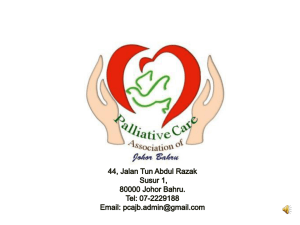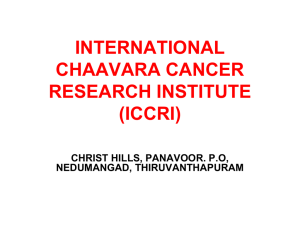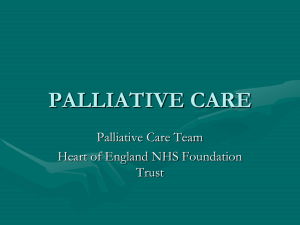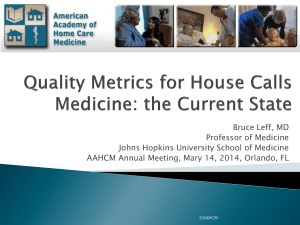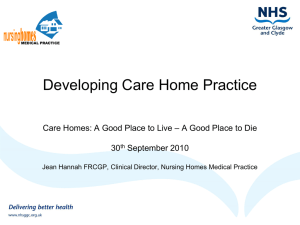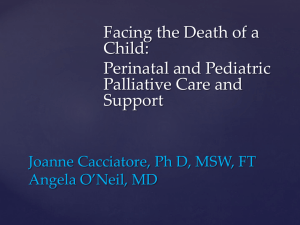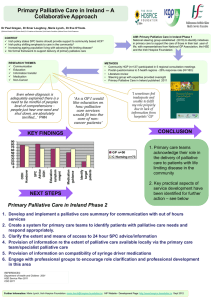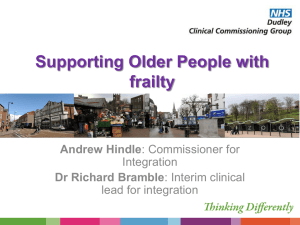Consolidated Presentation Slides for LS1
advertisement
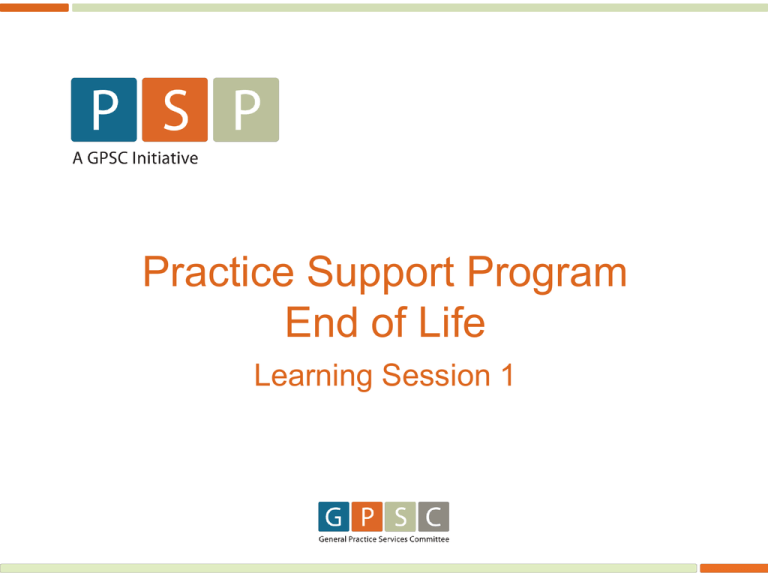
Practice Support Program End of Life Learning Session 1 Ambiguous dying “There will not be a distinct terminal phase. The week we die will start out like any other and some unpredictable calamity will occur. Amongst those of us with advanced heart failure, we will have had a 50-50 chance to live for six months on the day before we died” Joanne Lynn: Sick to Death and Not Going to Take it Anymore (2004) 2 Agenda <as per your timing> <note: slides with an O are optional> 3 How is a collaborative different than CME? Action-oriented: try what you learn – “What are you going to do next week?” Test and implement in small populations, then spread to the larger population Discussion with colleagues 4 Learning Sessions and Action Periods LS1 LS2 AP1 LS3 AP2 5 PSP physician payments Module # of Sessions Learning Session 1 MOA salary replacement 1 4 hours @ $20/hr $ $ 407.81 80.00 Action Period 1 2 $ 815.62 Learning Session 2 MOA salary replacement 1 4 hours @ $20/hr $ $ 407.81 80.00 Action Period 2 1.5 $ 611.72 Learning Session 3 MOA salary replacement 1 4 hours @ $20/hr $ $ 407.81 80.00 Total Payment Total Payment $ 2,890.77 6 Module aims Module aims Improve the care of patients and families living with, suffering and dying from life-limiting and chronic illnesses by: Early Identification (Registry Building) Enhance and Improve physician confidence related to End of Life care (e.g. care planning, forms, communication, resources) Improve Collaboration (clarity of roles, appropriate resource referrals, network of community resources, etc) Improve the experience of the patient, family, physician, MOA and healthcare providers in End of Life care. 8 Module aims Improve the care of patients and families living with, suffering and dying from life-limiting and chronic illnesses by: Early Identification (Registry Building) Enhance and Improve physician confidence related to End of Life care (e.g. care planning, forms, communication, resources) Improve Collaboration (clarity of roles, appropriate resource referrals, network of community resources, etc) Improve the experience of the patient, family, physician, MOA and healthcare providers in End of Life care. 9 Module aims To improve the care of patients and families living with, suffering and dying from life-limiting and chronic illnesses by: Improving collaboration: o Identifying and referring appropriate patients to specialty palliative care and others for consultation and services. “Integration in Action” o Understanding provider needs, clarifying roles, tools and resources for practice support and collaboration. o Improving collaborative care planning, coordination and communication with patients/caregivers and physicians and other local health care and community providers. 10 End of Life Regional PSP Outline 11 PSP End of Life Care Algorithm 12 O The patient and family voice End of Life Care: Expanding the scope Changing the face of dying We are living longer. By 2025: 30% of the population >65. 33% increase in deaths over 2004. 2/3 will die with 2 or more chronic diseases after months or years in state of “vulnerable frailty”. Only 20% of us will die with a recognizable terminal (“palliative”) phase. 15 O Cause of deaths in Canada 16 O 17 End stage organ failure: Approaching End of Life Terminal Phase Function High Low Begin to use hospital more often, self-care more difficult Death Time ~ 2-5 years. Death usually seems “sudden” Modified from Lunney JR et al. JAMA 2003: 289: 2387. 18 Ambiguous dying “There will not be a distinct terminal phase. The week we die will start out like any other and some unpredictable calamity will occur. Amongst those of us with advanced heart failure, we will have had a 50-50 chance to live for six months on the day before we died” Joanne Lynn: Sick to Death and Not Going to Take it Anymore (2004) 19 20 The Palliative Approach to life-limiting illness Canadian Hospice Palliative Care Association: Model of care (2002) www.chpca.net Bereavement Care Disease-modifying therapy Palliative Approach to Care Diagnosis of life-limiting illness Death Illness trajectory 22 WHO definition of palliative care Palliative care is an approach that: Improves the quality of life of patients & their families Through: Prevention and relief of suffering By: Early identification Impeccable assessment & treatment http://www.who.int/cancer/palliative/definition/en/ 23 Palliative Approach Guided by person centered goals of care: 1. 2. 3. 4. 5. 6. 7. Pain and symptom management. Psychosocial care for person. Psychosocial care for family. Spiritual care. Disease management. Preparing for and managing dying. Bereavement. (Canadian Hospice Palliative Care Association: Norms, 2002) 24 Palliative Approach: Care through all the transitions Early Chronic Disease Management Disease advancement Survivorship Decompensation experiencing life limiting Seniors at risk illness Dependency and symptoms increase Decline and last days Death and bereavement Transition 1 Transition 2 Transition 3 Transition 4 Transition 5 Time of Diagnosis Patient Journey McGregor and Porterfield 2011 25 Best practice: Collaborative and interdisciplinary Palliative Care Australia 26 Evidence for an expanded scope of the Palliative Approach to care in family and specialty practice? Study design/Measures 151 participants (patients recently diagnosed with metastatic non-small-cell lung cancer) were randomly divided into either an early palliative care cohort or a standard care cohort The study examined… Quality of life Mood Survival 28 Improved quality of life 29 O Improved mood 30 Improved survival 31 O Study conclusions Those who were assigned to early palliative care had improved mood, more frequent documentation of resuscitation preferences and less aggressive end-of-life care. 32 Expected outcomes of an early palliative care approach “Good death” in the most appropriate location. Better pain and symptom management. Better long term outcomes for bereaved relatives. Improved experience of care. Better quality of care. Lower health care costs. Zhang et al. Arch Intern Med Vol 169(5) Mar 9 2009:480-488 33 Table discussion Think about your self-audit OR a recent death of a noncancer patient you were involved with` Were you satisfied with the experience? › If so, what made it work? › If NOT satisfied, why not? What were some of the gaps in clinical care? What could have been done differently? 34 Identification of patients who may benefit from a palliative approach: The first step to improve the patient and family experience of care Who would benefit from a palliative approach? 36 PSP End of Life Care Algorithm 37 Identify patients: Gold Standard Framework triggers Three triggers for supportive/palliative care: 1. The surprise question: “Would you be surprised if this patient were to die in the next year? 2. Choice/need: patient makes a choice for comfort care only, or is in special need of supportive/palliative care. 3. Specific indicators: clinical indicators for each of 3 main EOL groups (cancer, organ failure, frail elderly /dementia). Sentinel Events is another trigger to help identify patients. 38 WOULD I BE SURPRISED IF JAMES LEE DIED WITHIN THE NEXT YEAR? Identify: Use prognostic indicators General: Co-morbidity. Recent, multiple ER visits/hospital visits. Complications of recent hospital stay. Reducing performance status (ECOG/Karnofsky/PPS). Dependence in most activities of daily living (ADLs). Impaired nutritional status despite attempts to improve › Serum albumin < 25 g/l. › Weight loss 5-10% of body weight (last 6 months). 40 Palliative Approach: Care through all the transitions 41 Sentinel event questions “Well, that was a close call. What were you thinking about when this happened?” “What if things don’t go so well the next time?” “How did your family do during this time?” 42 Identification: Table discussion (15 minutes) How will you think differently about identifying patients? How will you communicate and to whom? Registry building – what approach will you take? Consider who should be involved in your community and when would it be appropriate to refer? 43 Patient registry and flagging charts Include patients with advanced disease: › › › › › › › Cancer AIDS COPD and other chronic respiratory conditions Chronic heart disease Renal failure Neurological conditions, including dementia Frailty or multiple co-morbidities Consider patients in residential care as a target population 44 Identification - what changes do you see?..... Flagging by MOA Changes in appearance Missing appointments Admissions to Long Term Care or multiple hospital visits or even frequent doctors visits Family members expressing concern, wanting to talk to the doctor about them Changes in behaviour Changes in gait Decrease in ability to care for themselves Changes in communication Gut feeling 45 Identification: Pearls What have we learned? 1. The whole team can seek to identify potential patients. 2. Tools are available to support identification › Surprise question (intuitive awareness of transition). › Choice (readiness of patient). › Clinical indicators (Functional/Prognostic signs). 3. Tools are available to support identification. 46 Break Communication Communication cont. Goals of this section: Review and discuss key pearls pertaining to ACP discussions. Review videos of ACP conversations and discuss. Hear about your experiences holding ACP conversations. 49 Critical importance of communication Six key components: 1. Talking with patients in an honest and straightforward way. 2. Willing to talk about dying: Not abandoning / avoiding the dying patient. 3. Giving bad news in a sensitive way: Balancing being realistic with maintaining hope. 4. Listening to patients. 5. Encouraging questions. 6. Sensitive to patients readiness to talk about death. Weinrich et al. Communicating with dying patients within the spectrum of medical care from terminal diagnosis. AIM 2001; 161: 868-874; Curtis, J Gen Intern Med 2000; 16:41 50 Empathy Listen for feelings, fears, concerns as well as who this person is and what is important to them Where are they in disease trajectory? Are they in transition from one stage to another Even if you don’t think you can connect easily, you can learn to do this 51 Breaking bad news - SPIKES Iatrogenic suffering – what families remember Breaking bad news (Buckman) Setting Patient Perception Invitation Knowledge Empathy Strategy & Summary not YIKES! 52 When to hold ACP conversations Patients often give you an opening….. Patient history form / intake assessment. Annually for all adults: “I talk with all my patients about this and we talked a little about this last year…” Part of chronic disease management: “Hope for the best but plan for the worst…” "This illness can have a fairly predictable course…here are some things you need to think about ahead of time…" Following ER / Hospital admission: “I understand you have been in the hospital. What did the doctors say?” 53 !!when available insert image of the MOH pt guide “My Voice” is a guiding document for ACP conversations. Documents patients wishes concerning… › Medical Interventions › CPR/No CPR › Friends and family to assist in decision making on behalf of the patient. Also describes location of other pertinent planning documents. Provincial ACP guide available soon Will include documentation re: › advance directives › representation agreements › providing contact information › for temporary substitute decision makers 54 Scripted question (see handout) 1. What do you think is the cause of your health condition/symptoms? 9. You and I have talked about CPR, and I gave you some booklets on it. What have you learned about CPR? 2. How much intervention do you want? (i.e., No assisted ventilation? BIPAP? Better symptom control?) 10. What do you understand about your health condition? What does your family understand? 3. What do you hope for with this current plan of care? What else do you hope for? 11. What do you know about the possible complications of _______________ (kidney failure, COPD, CHF, etc.)? 4. What fears or worries do you have about your illness or medical care? 12. Are there any other concerns you have about your health care wishes? 5. What was your last hospitalization like? What did it mean to you? 13. How has your illness interfered with your daily activities? 6. Have you talked with your family about your wishes for future medical care? 14. Tell me what you understand about the options for treating your illness. 7. If you weren’t able to make your own health care decisions, who would make them for you? 15. What treatments/medications interfere with your quality of life? 8. How comfortable are you talking with your family/friends about these wishes? Skills-based practice session Groups of 3 › Each scenario has 3 roles: patient, clinician, and observer. › Choose role you wish to play. › Take 1-2 minutes to review your role. › Clinician initiates the 5 minute conversation. › Take 2 minutes to review the role play together. 56 Review skills-based exercise What feelings did you experience as you played the role of the patient? What did you learn as you played the role of the observer? In the clinician role, what surprised you? What 1 thing might you change about your ACP conversations in the future? 57 Group discussion Your experiences with ACP conversations 58 Collaboration with your local team Objectives Who is on the local Primary Care Team? What does primary care team collaboration look like? Involvement varies based on Transition Working with › Home and Community Care › Specialty palliative care team › Non-palliative consultants (specialists) Local resources + CHARD reference Discuss when to refer in your community. 60 Who is the patient’s care team? Patient, family and informal network Family physician Community pharmacist Home Health / Community Care – Nurses/rehab/home support Nurse practitioners, community RT Disease specific consultants / services Hospice palliative care consult teams 61 Palliative Approach: Care through all the transitions Early Chronic Disease Management Disease advancement Survivorship Decompensation experiencing life limiting Seniors at risk illness Dependency and symptoms increase Decline and last days Death and bereavement Transition 1 Transition 2 Transition 3 Transition 4 Transition 5 Time of Diagnosis Patient Journey McGregor and Porterfield 2011 62 Transitions in life-limiting illness 63 Transition 1 Advancing disease Would NOT be surprised if patient died in next year – Discuss goals, wishes & plans as illness advances. Initiate advanced care planning. – Identify other involved providers & ensure information exchange. – Medical assessment of patient symptoms, needs & supports. – Consider referral - Chronic disease clinics. Home and Community Care if functional status declining and home based supports needed. 64 Transition 2 Decompensation Prognosis months vs. more than a year; cancerPPS 50% Focus on Integrated Care Planning & Coordination with Home and Community Care Coordination of care conversation: GP and HCN. Enable ready access to achieve co-provision of care vs. parallel practice. Assess needs and develop plan Tools – BC Palliative Care Benefits application (drugs & HCN assessment); GP letter from Home Health 65 Working together GP and Home and Community Care? 66 When to refer to HPC specialist: Indicators Complex patient / family needs or anticipated illness course. Distress with symptoms or coping remains › No resolution within 2-3 interventions. › Distress continuing. › Complex family dynamics and indications of total pain. Self reflection - knowledge, skill and ability of involved team in relation to patient/family needs. 67 Specialist-GP shared care • Communicate: • relevant patient-specific information • family issues if relevant. • Clarify early in Specialist-GP relationship: • roles in care of patient through transitions of Chronic Disease Management • needs, expectations and outcomes from the consultation • Indicate lines of communication/availability to share care effectively. 68 Specialty practice and EOL O – when SPs are not attending • If palliative approach appropriate: • reflect in treatment recommendations • give GP permission/advice about stopping medications. • Inform patient/family • All options including palliative care with no active treatment • realistic outcomes of treatment options • Give patient ACP planning documents: • follow up with all care providers – include in communications to GP 69 Specialty practice and EOL O – when SPs are not attending Shared care through end of life Include recommendations for disease specific symptom management as patient approaches end of life. Indicate availability for access to advice throughout transition to support GP in the care of patient at end of life. (telephone fees available to both to support) 70 Telephone fees to support GP-Specialist shared care at EOL • Urgent advice needed (< 2 hours) O – when SPs are not attending – Specialist fee G10001 – GP with Specialty training fee G14021 – GP requesting urgent advice fee G 14018 • Less urgent advice (up to 1 week) – Specialist fee G10002 – GP with Specialty training fee G14022 – GP requesting advice as part of Community Patient Conferencing (patient lives at home or in assisted living) fee G14016 – can also include discussion of management plan with Home Care Nurse or other AHP – per 15 minutes or greater portion. 71 A web-based directory of specialists and services, containing detailed referral information to help you locate appropriate and available resources for your patient Over 26,000 referral resources at your fingertips Health authority & other publicly-funded services Private, fee-based services All specialist physicians A variety of allied health professionals Improve your referral efficiency and effectiveness Cut down on the time & frustration finding the right resource for patients Access relevant, detailed and organized information to ensure appropriate and complete referrals to the right provider Built by and for physicians An initiative of the General Practice Services Committee (GPSC), operated by HealthLink BC, with input from physicians & MOAs 72 Collaborative practice: Table discussion Think about your practice in relation to the palliative approach + transitions 1 and 2 1. 2. 3. How can you more effectively work as a team with these patients? How can you support one another? What could you do differently to maximize the roles and time of all primary providers? 73 Collaborative practice: Table discussion Identify one aspect of care that you will do differently in your practice. 74 Action period planning Module aims To improve the care of patients and families living with, suffering and dying from life-limiting and chronic illnesses by: Improving collaboration: o Identifying and referring appropriate patients to specialty palliative care and others for consultation and services. “Integration in Action” o Understanding provider needs, clarifying roles, tools and resources for practice support and collaboration. o Improving collaborative care planning, coordination and communication with patients/caregivers and physicians and other local health care and community providers. 76 76 PSP End of Life Key Measures – Measured by practice # of patients identified and placed on a registry. % of patients on a registry with a collaborative proactive care plan in place. % of patients on patient registry that have been given My Voice and had an ACP conversation. % of patients on the registry that had an ESAS and or PPS (as appropriate). 77 77 Key measures – non-practice based % of GPs and healthcare providers that have an improved experience in caring for patients at End of Life. % of GPs that are confident when engaging patients and their family in conversations about End of Life (1-10 confidence scale). % of patients/caregivers who feel comfortable with their End of Life care plan. % of caregivers who feel supported when caring for patients at End of Life. 78 78 Finding changes End of Life change package. Team ideas. Peer changes. 79 79 Friendly reminder The Action Period is the time in-between learning sessions It’s where you do stuff 80 Action Period 1 planning <YOUR FORM> Pt Identification Communication Collaboration 81 O Payment forms
